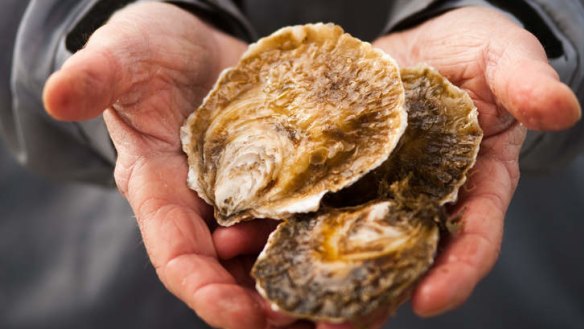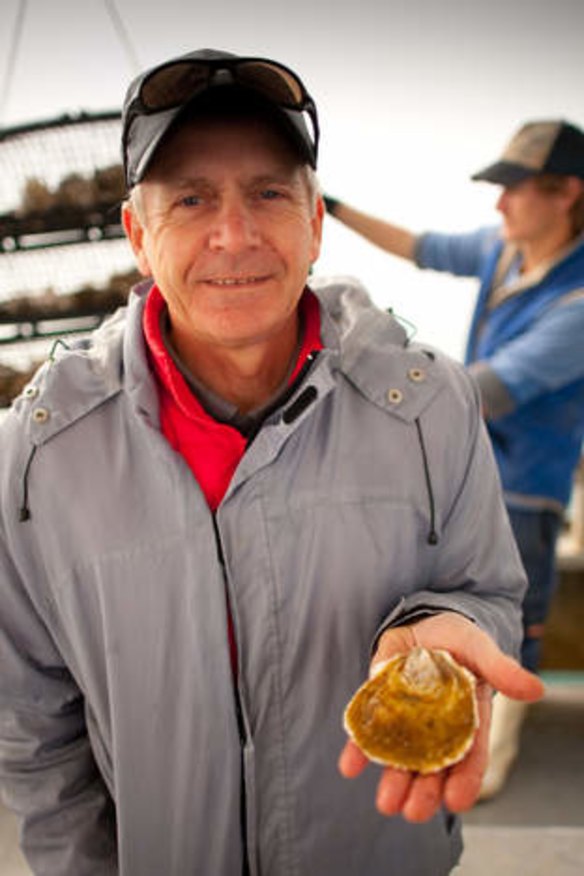Return of the native as grower flexes his mussels

Fat, flat and as big as your palm, Port Phillip Bay's native oysters are back on the plate. Portarlington mussel grower Lance Wiffen from Sea Bounty Mussels has gone out on a limb and this year has grown 20,000 native oysters in the southern end of Port Phillip Bay. He is one of three growers reviving the native oysters of Port Phillip Bay.
Native oysters are called ''muddies'' by fishermen, ''flats'' by chefs and Ostrea angasi by scientists. They are naturally a bottom-dwelling oyster that lives on the floor of the bay, bedding themselves down into the sand or silt and filter feeding on algae and micro-plankton. They are found in the shallow, sheltered coastal waters around Victoria and Tasmania.
Great middens of native oysters dot the sand dunes around Port Phillip Bay, where Bunurong and Wathaurong Aboriginal people sat down on the beach for Melbourne's original oyster frenzies. The feast continued during the gold rush when oysters dredged from the bay were served with French champagne chilled on ice shipped from America. Back then the oysters gathered in big reefs ringing the bay. Their shells were also burnt to make lime for cement to hold together what are now our fine old buildings. Our appetite for oysters was insatiable and by the 1880s, after Melburnians had eaten almost all the oysters in the bay, we began shipping them in from Tasmania. Within a few generations we had eaten out one of the great oyster waterways of the world. Well, almost.

Thankfully small colonies of native oysters survived. Their descendants were recruited by Wiffen and fellow oyster farmers for the new venture. In his hatchery, Wiffen manipulates the water temperature to make the oysters spawn. Soon tiny oysters float around in tanks feeding on algae that Wiffen grows in large plastic tubes. The oysters are kept in circulating water to stop them clumping together. When they are three millimetres wide, they are taken to sea and grown in cages until they are the size of a 50¢ piece, then attached to long lines of nylon rope. These are shipped out to Wiffen's farm, leased from the state government in the middle of the bay and suspended five metres underwater in Pinnace Channel, which has a sandy floor on which sea grass grows. Here they grow and fatten and, at 18 months, are harvested, cleaned and packed.
"I have to pack them in plastic [bags] because, unlike oysters that are exposed at high tide, ours are underwater feeding all the time," Wiffen says. "That means they grow faster but are not trained to open and close. The bag keeps them closed so they keep alive in good condition for over a week."
The native oysters are easy to open with an oyster knife inserted into the rear of the hinge and twisted, then the blade given a flick to cut the adductor muscle. Being flat they don't hold a lot of juice and are quite salty compared with Sydney rock oysters, a native to the east coast of Australia, and Pacific oysters, introduced from Japan. The adductor muscle is large, meaty and very sweet. Having grown in the water column and not on the sea floor, these farmed native oysters do not have the usual gritty texture and muddy taste. Instead Wiffen and his team have created an oyster that tastes of the bay with sweet pleasant overtones of the sea grass. As one taster said: "It reminds me of learning to swim at Brighton Beach on a lovely summer's day."
Wiffen has already started next year's batch of 200,000, which will be harvested from April next year, and is exporting his oysters to Hong Kong.
WHERE TO BUY
Ocean Made Seafood 27-29 Robert Street, Collingwood. Recommended retail: $18 a dozen.
WHERE TO TRY
Port Phillip Bay native oysters - or ''flats'' - are being served at Pure South, city; Morris Jones and Co., Prahran; and the Carringbush Hotel, Abbotsford.
Restaurant reviews, news and the hottest openings served to your inbox.
Sign up- More:
- Restaurant news
